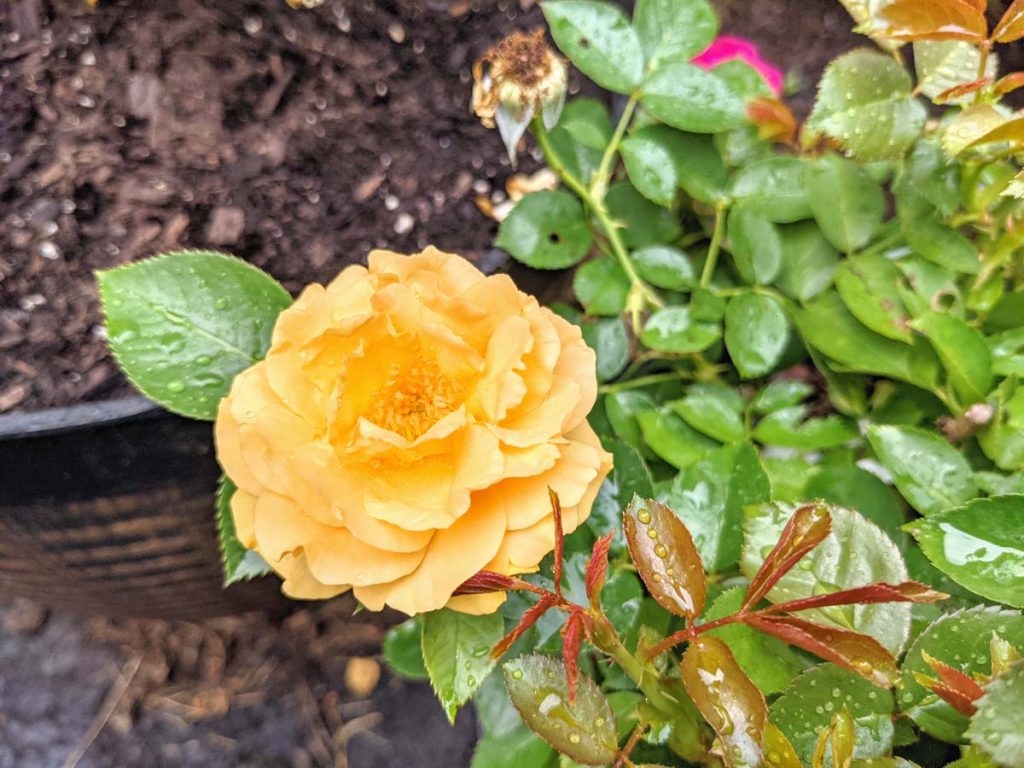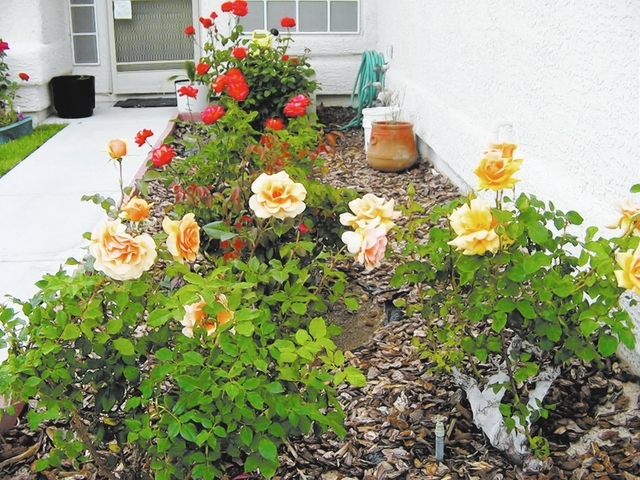
All varieties of rose benefit from moderate air movement around their leaves to stave off common ailments like powdery mildew. However, rose producers face a number of challenges when exposed to consistently windy environments…
Regosa roses thrive in windy environments. To create a barrier against strong gusts, plant a natural windbreak, such as conifers. In windy environments, roses often require extra water, a decent fertilizer, frequent mulch applications to retain water, and strategic pruning to lessen wind resistance and ensure that only the strongest, most durable growth is left.
You may effectively grow roses in windy locations with an abundant bloom display with some careful planning. Let’s take a closer look at the best advice to make sure your rose prospers.
Table of Contents
1. Choose a Rugosa Rose for Windy Areas
The rugosa rose is one of my favorite types of rose and is without a doubt the greatest kind for windy gardens.
Rugosa roses come in a variety of colors, scents, and flower shapes, but what unites them all is their high hardiness, disease resistance, tolerance of windy circumstances, and capacity to survive in coastal environments with frequent contact to sea spray.
Rose producers prize rugosa roses for their capacity to thrive in sandy soil and to withstand brief periods of drought.
It is the ideal rose for gardens with wind because of its capacity to flourish in challenging circumstances.
2. Create a Natural Wind Break with Conifers or Yew Hedges
I would always advise building a natural or artificial wind break in regions that are frequently windy and exposed in an effort to attempt to deflect powerful gusts.
An evergreen with dense vegetation, like a conifer, is ideal for this. Conifers maintain their foliage all year long, so they will continue to offer protection to roses during the winter, when wind can be particularly severe.
Conifers are the best choice since they can withstand wind on their own and develop in a uniform, nearly opaque barrier as opposed to other shrubs and trees, which could form sparse branches and not take on the shape you require without intensive care over time.
Conifers are also easily accessible at nurseries, garden centers, and even online, and may be purchased at the right height and size to be planted as a barrier for your rose bush, saving you the time and patience needed to wait for the tree to reach the right size. The advantages of instant gardening!
Since your roses require at least 6 hours of direct sunlight each day, it’s crucial that the conifers do not block their light, thus I would suggest planting your barrier vegetation at least 4 feet apart.
Since roses are heavy feeders and need a lot of nutrients, planting other shrubs too close would force them to compete with the rose for water and nutrients, which could be harmful to the rose.
Of course, there are other shrubs you may want to utilize as a windbreak, or you may decide to use an artificial windbreak like a trellis or some fencing. You also don’t have to use a wall of conifers.
Remember that roses benefit from some air movement because it helps avoid infections; instead of crowding your rose, attempt to block straight, persistent strong winds that dry it out.
3. Water Twice per Week with 4 Gallons if it’s Hot and Windy

You should water your rose more frequently than usual if you are undergoing a heat wave or reside in an area that is extremely dry, like Arizona.
The conventional wisdom for watering established roses is to give them a good bath once a week and let the soil go a little bit dry in between applications since rose roots prefer adequate drainage over prolonged exposure to water.
Arid air will just make the issue worse because, when it’s windy, leaf transpiration will be more than usual.
In these circumstances, you should check your rose for any indications of heat exhaustion. This can be evidenced by yellowing or curled-and-drooping leaves.
I advise watering your rose twice in a week with 4 to 5 gallons of water each time if you experience scorching temperatures, little to no rain, and wind during the growing season (spring and summer).
As it might be time-consuming and exhausting to repeatedly refill the watering can, you might choose to utilize a soaker hose at this time.
Best Practice: Stick your finger into the dirt around the rose’s base to determine whether it needs watering. If you find any moisture, stop watering and test the soil again after another day or so. This is the ideal time to generously water your rose if the soil is dry.
Don’t feel as though you have ignored your rose because roses prefer when the soil dries out a little between waterings. It enjoys the irrigation cycle known as “soak and dry.”
Always give your roses at least one weekly watering, unless you’ve received more than an inch of rain in the previous seven days; even then, I’d check the soil just to be sure.
As an alternative, I really enjoy using a device from Amazon that analyzes soil moisture, sunlight hours, and soil pH. Rose growers value all three of these aspects, and the greatest part is that they are all inexpensive!
4. Apply Mulch Twice a Year in Windy Areas to Retain Water
One of the best things you can do to preserve the health of your rose is to periodically apply mulch in windy areas.
The main advantage of mulching around roses in windy gardens is that the organic material will aid in the soil’s ability to retain moisture.
In order to counteract the drying effects of wind, using water-absorbing mulch will help your roses suck up more water. Wind can rob soil of moisture.
In windy gardens, leaf mold, well-rotted manure, and compost prepared from regular kitchen and garden waste are the three best mulches for roses.
This is because, compared to other typical mulches like wood bark or straw, they all have a remarkable capacity to hold onto water.
While these three mulches trap water, they also create a framework that lets extra water drain away, creating the perfect environment for roses. Before the wind dries out the soil, the rose’s roots will have more opportunity to absorb the liquid there.
The best technique to make leaf mould is to shred the leaves with your lawnmower, then put the shredded leaves in a compost area and let them rot until they are partially decomposed before using as a mulch and preventing them from blowing away.
Mulch also enhances soil ecology, balances pH, enhances drainage, improves soil structure, and gradually releases nutrients for increased fertility.
Around the base of the rose shrub, spread a two-inch layer of mulch. The rose canes should have a 3-inch space between the mulch and them since the wood above ground dislikes being exposed to moisture that is there all the time.
In order to protect the roots from the worst of the winter’s cold, I personally do this twice: once at the beginning of the growth season in April or May and again in September.
The mulch will keep the ground moist, keep the roots cool in the summer heat, and inhibit weed growth.
5. Roses in Windy Areas Need 6 Hours of Sun per Day and a Good Fertilizer
You need to make sure your rose is as healthy as possible if you want it to grow into the strongest, most robust variety that can withstand windy areas.
This includes exposure to the sun, preferably for longer than six hours each day. Less sun exposure or exposure to partial shade causes roses to become lanky, weaker, and their canes and new growth may droop downward.
Roses that are weak and leggy are visibly more vulnerable to wind damage. Make sure your rose gets adequate sunlight so it may grow and flourish. If not, I advise moving the rose to a more hospitable sunny location. You can also make sure that no nearby trees’ overhanging branches have gotten too big and are now depriving your rose of valuable light.
If so, remove the umbrella so your rose can bask in the lovely sunshine! Additionally, you’ll notice better blossoms.
The vigor and resistance of your rose will increase with a regular fertilizer regimen, and the blossom show will be enhanced. Visit my article here for a detailed explanation of how to organically fertilize roses.
As an alternative, I always advise miracle grow rose and shrub fertilizer for novice rose growers.
It has all the components in the proper proportions that a rose needs to thrive. It is also designed to only need two treatments a year, once at the first site of flower buds and once more at the second flush of buds.
All you have to do is rake the mulch to one side, sprinkle the granules onto the ground, and then rake it back in after giving it a good wetting.
It is incredibly easy to use, and I have gotten outstanding results, especially considering how many flowers are in bloom right now.
6. Prune Properly Every Year in Spring to Prevent Wind Damage
Weaker growth is also far more vulnerable to wind damage, and dead wood will do nothing but increase the rose bush’s wind resistance.
The strongest, toughest rose canes should remain after a light pruning, making the entire bush smaller, lower to the ground, and less exposed.
This will promote the growth of a rose that is stronger, healthier, more disease-resistant, and able to produce more flowers. I always give my roses a light pruning in the spring, typically in late March.
The best time to prune is when growth is just getting started; the uppermost buds will appear to be expanding but no leaves will have yet formed.
Visit this YouTube video to view a comprehensive approach to pruning roses.
Conclusion
Regosa kinds of roses are highly recommended if you are growing roses in a windy garden because they are known for their resistance to wind, disease, and other unfavorable situations. They also have a lovely aroma and are a lovely example of a rose.
Planting a natural wind break to block the strongest gusts is always a smart idea when the wind is particularly persistent.
In order to prevent wind from evaporating the water from the rose and soil, cover the soil with a good water-retentive mulch, like leaf mold, and hydrate the rose at least once a week with 4 liters of water during the growing season. I would advise you to water your roses twice a week if you are experiencing hot weather or live in an area that is inherently arid.
The best irrigation advise is to follow your instincts, respond to the weather, and take appropriate action. Give your rose a good soak if it is displaying indications of stress, such as drooping foliage.
To ensure that your rose is as healthy and robust as it can be, take good care of it with proper fertilizer, frequent mulching, and suitable pruning. Your rose should flourish in a windy region.
